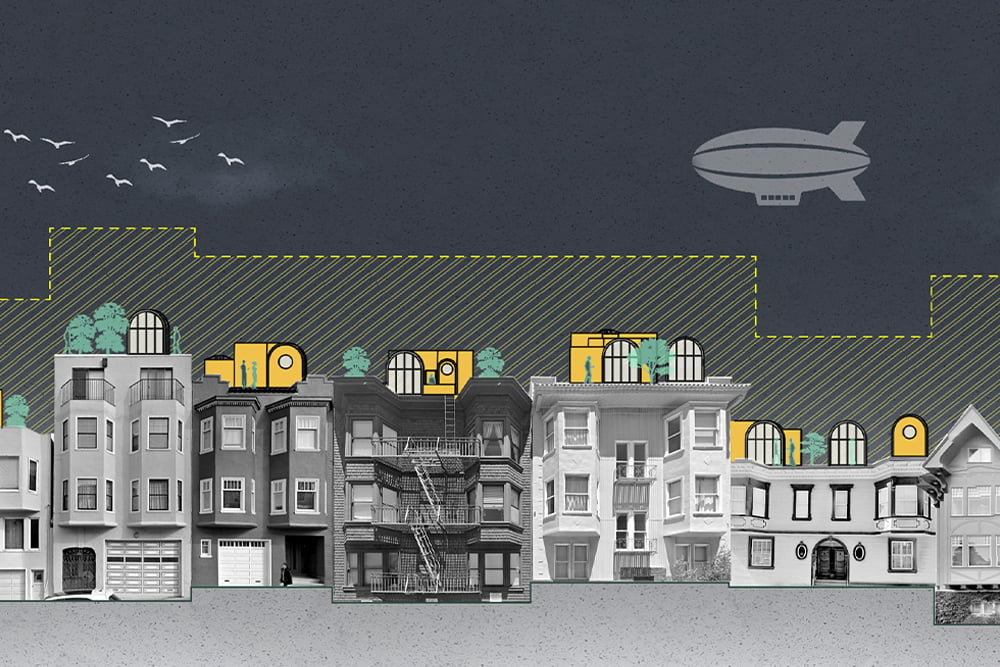Upper Lands (Proposed creative solutions to San Francisco’s housing crisis)

In the “Imagine Housing” series of articles, we pose creative solutions to San Francisco’s housing crisis – increasing city density without compromising on character. In this edition, we turn our gaze upwards and take in the views from our city’s rooftops.
- WORDS BY
- Dane Bunton
- Date
- 08.20.2020
- IMAGERY BY
- Studio BANAA
“Land” is not a dirty word.
Imagine the same San Francisco you love, but with 30 percent more land available. Lower rents, ample housing and little-to-no impact on the existing cityscape. What if we told you we could achieve this without one square foot of actual dirt? You’d likely tell us we’re dreamers. At Studio BANAA we are, but in this case we don’t need to be. Because the future of San Francisco housing is literarily looking up.
As part of the Bee Breeders San Francisco Affordable Housing Challenge, we’ve been brainstorming systems to unlock the potential of rooftop architecture. The concept is simple: when you think of a flat roof as essentially the same as the building’s original physical footprint, there are huge benefits in reclaiming some of this highly sought-after available “land” for affordable housing. And with around 30 percent of San Francisco’s total land area composed of rooftops, that’s a whopping amount of potential to tap into.
Site-specific solutions, from the ground up.
The key to developing any successful rooftop system is the ability to build on top of another building with minimal modification to the original. Just as Rem Koolhaas envisaged skyscrapers as frameworks for creating “land” via a rack system for a variety of different uses, another critical component is a “ground-up” approach. That is, builders and owners designing site-specific responses on a rooftop-by-rooftop basis. This is important for two reasons:
- Every building is different – custom, fit-for-purpose responses allow developers to meet their budgets, technical requirements, and overarching goals.
- Every community is different – there must be flexibility for architects and property owners to develop underutilized spaces to maximize economic, social, and environmental benefits, while adding value to the city’s aesthetic.
Don’t be afraid of heights.
Of course, lofty dreams bring enormous challenges. Weight, rooftop access and delivery of services like plumbing, electrical and heating/cooling must be addressed in any rooftop structure. And because no two rooftops are the same, we’re incorporating maximum flexibility of design in our two proposed systems.
The first is series of prefabricated, self-sustaining housing structures that are lightweight, affordable, easily assembled and transported. The goal here is to plug into and preserve the existing building as much as possible, while making use of existing access stairwells, elevators and penthouses.
The second is a cantilevered platform system that can be installed and adapted to support structures designed by other architects and developers. The goal here is to create a system that only lightly touches the existing rooftop. And from this baseplate – if you will – developers can build structures that are in tune with their location and goals.
Both solutions incorporate passive heating/cooling, solar technologies and black/greywater recycling to achieve as close to absolute self-sufficiency as possible. And whether you have fantastic access and a sufficiently reinforced roof structure, or zero access and paper-thin walls, our dual options can be adapted to fit.
San Francisco’s housing future is looking up.
It will take bold ideas to solve the San Francisco housing crisis. We believe that increasing affordable housing density needn’t come at a cost to our iconic cityscape, or the environment. As we cast our eyes to these Upper Lands, we do so with the future sustainability of our city in mind, as well as maximum sensitivity to the displacement of who and what’s already there.
For us, being green means not only self-sufficiency and using natural resources. It’s also about reusing existing buildings instead of creating new ones, preserving our heritage, and housing San Franciscans in a more equitable way. And although rooftop architecture won’t provide a solution to our crisis in and of itself, reclaiming and developing rooftop spaces is the perfect place to start.